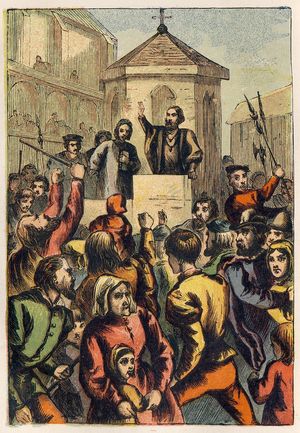Timothy Cross continues explaining the Apostles’ Creed
It is striking that the creed goes straight from Christ’s birth at Bethlehem to his death at Calvary thirty-three years later, giving no mention to the remarkable life he lived.
Here, the creed is squarely in line with Scripture, for the Bible’s emphasis is not so much on Christ’s life as his death. All roads lead to the cross of Calvary, for it was there that Christ actually procured the eternal salvation of his people.
Christ’s living was with a view to dying. It is his atoning death for sinners that is the sum and substance of the Christian gospel. ‘We preach Christ crucified’ (1 Corinthians 1:23).
He suffered under Pontius Pilate
Pontius Pilate’s inclusion in the creed places Christ’s death firmly in world history. Pilate was the Roman governor of Judea from AD 26-37. Roman assent was required to inflict capital punishment, and this Pilate gave when he ‘took water and washed his hands before the crowd … and having scourged Jesus, delivered him to be crucified’ (Matthew 27:24-25).
In 1961, extra-biblical evidence was found for Pilate’s existence at Caesarea, in the form of a stone slab bearing his name. Truly ‘we did not follow cleverly devised myths when we made known to you the power and coming of our Lord Jesus Christ’ (2 Peter 1:16).
He … was crucified
Crucifixion was a barbaric form of capital punishment invented by the Romans. It entailed the victim being nailed to a plank of wood and hung up to die a long, lingering death by asphyxiation.
The stress of the Bible, however, is on Christ’s spiritual sufferings rather than his physical ones. Old Testament law stated: ‘If a man has committed a crime punishable by death and he is put to death, and you hang him on a tree, his body shall not remain all night upon the tree, but you shall bury him the same day, for a hanged man is accursed by God’ (Deuteronomy 21:22-23).
In Galatians 3:13 Paul gives a Christological interpretation of this verse, which takes us to the heart of the meaning of Christ’s crucifixion. He states: ‘Christ redeemed us from the curse of the law having become a curse for us – for it is written “cursed be ever one who hangs on a tree”’.
Paul is explaining that when Christ was crucified at Calvary, he was cursed by God that the believer might be blessed by God. He was judged by God that the believer might be justified by God. He was punished by God that the believer might be pardoned by God. ‘He was wounded for our transgressions’ (Isaiah 53:5); ‘he himself bore our sins in his body on the tree’ (1 Peter 2:24).
At Calvary, God’s judgement and mercy met, enabling him to condemn sin and pardon the believing sinner. Jesus endured God’s wrath to save us from that wrath. ‘He is the propitiation for our sins’ (1 John 2:2; 4:10).
He … died
The earliest ever verbal distillation of the Christian Faith stated succinctly ‘that Christ died for our sins in accordance with the Scriptures’ (1 Corinthians 15:3). Scripture teaches that death is God’s punishment for sin.
Death in the Bible refers to the separation of the soul from body and eternal separation from God in hell – ‘the second death’ (Revelation 2:11). Christ endured all this in the place of sinners when he died at Calvary. ‘He was put to death for our trespasses’ (Romans 4:25). He suffered both physically and spiritually.
Sinless himself, he died in the place of sinners, and bore their punishment to save them from the ‘second death’. Paradoxically, he died that we might live. ‘The wages of sin is death but the free gift of God is eternal life in Christ Jesus our Lord’ (Romans 6:23).
He was … buried
Jesus’ burial refers to his loving entombment by Joseph of Arimathea, who ‘took the body [of Jesus] and wrapped it in a clean linen shroud, and laid it in his own new tomb, which he had hewn in the rock’ (Matthew 27:59). Christ’s burial is the bridge between his death and resurrection, and attests to the reality of both.
He really did die and pay the wages of our sin in full. He really did rise from the dead three days later. Joseph of Arimathea’s vacant tomb and the undisturbed grave clothes it contained are amongst the cumulative evidence proving that Christ conquered the grave.
Grace
The depths of God’s grace, in Christ, at Calvary, can never be plumbed. Christ died as the sinner’s substitute. He was punished that we might be pardoned. He was judged so we might be justified. He endured it all, ‘that we might go at last to heaven, saved by his precious blood’.





















